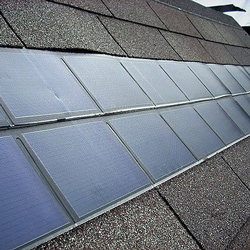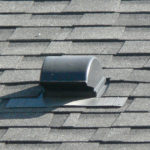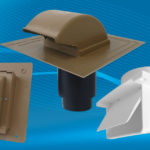 As homeowners become more energy-savings conscious with the rise in utility costs, they look for inventive ways to reduce power consumption in their homes. Fortunately, renewable energy alternatives have steadily increased over time with solar being the fastest growing alternative power option available today.
As homeowners become more energy-savings conscious with the rise in utility costs, they look for inventive ways to reduce power consumption in their homes. Fortunately, renewable energy alternatives have steadily increased over time with solar being the fastest growing alternative power option available today.
One of the newest advancements in solar power is the solar roof shingle. These are a hybrid of standard solar panels and roof shingles. Solar roof shingles, also known as photovoltaic shingles, protect the roof like traditional asphalt shingles, but can also transform the roof into an efficient energy producer.
The slender shingles harness the power of the sun to deliver an unlimited supply of clean, safe, renewable energy for heating, cooling and electricity. According to Roofpedia.com, solar roof shingles have been recognized as the best innovative green roofing product in recent years.
The CIGS breakthrough
Commercial solar shingles were first introduced in 2005 but encountered several failed starts with high costs and low electrical conversions rates of only 10%. In 2008, the U.S. Department of Energy’s National Renewable Lab (NREL) achieved a scientific breakthrough with the development of the copper indium gallium diselenide (CIGS) thin-filmed solar cell. This discovery increased the electricity conversion rate to 19.9%, producing a highly efficient and user-friendly product at competitive prices.
How solar shingles work
Like traditional solar panels, solar shingles use the power of the sun to create electricity. Each solar shingle is made of individual photovoltaic cells (PV Cells), which contain layers of semi-conductive material, usually silicon. When photons of light hit the shingles, free flowing electrons are released. These electrons are captured by conductive metal plates, which then creates an electrical current.
Solar roof shingle manufacturers
After the development of the CIGS solar cell technology, Dow Solar entered the solar shingle market in 2009 and quickly became the biggest name in the industry. Their “Powerhouse” solar shingles are capable of producing 12 watts of power per square foot of roof. Unlike other installation methods that link the shingles to a battery backup system, these shingles are tied directly into the power grid (grid-tied).
This connection allows excess power to flow back through the electrical meter into the power grid, which reduces the electricity bill even further. The system also increases the value of the home because of its highly efficient use of solar for heating, electricity and reduced maintenance costs.
The shingles are wireless and snap together. They can be installed by regular roofing contractors because they are similar to asphalt shingles. The only difference is that an electrician must install an inverter box to access the power. As they are individual shingles they can accommodate existing roof vents but these should be of very high quality to reduce the need for replacement.
The company reports that a typical home with approximately 350 solar shingles on the roof can see a reduction of 40-60% in electricity bills. However, in a surprise move Dow announced in June 2016 that they will cease manufacturing the shingles. A spokesperson for the product announced that Dow “will transition its Powerhouse platform to a licensing business model, with a focus on driving growth in the global photovoltaic market.”
CertainTeed is now the leading manufacturer in the industry. Their solar roof shingle product line is called Apollo and, like Dow, they also produce a shingle that is tied to the grid. CertainTeed estimates that homeowners can save anywhere from 40-70% on their electricity bills with the Apollo solar shingle roof system. They also state that their solar shingles can be installed on new or existing roofs. Their system produces 13 watts per square foot of roof. CertainTeed shingles are available throughout parts of the United States and Canada.
Cost of solar roof shingles
The initial cost for a homeowner to install solar roof shingles can be more than $20,000. Keep in mind this cost is offset by the long-term savings, which vary depending on location, the size of the home, the weather, local utility rates, and the roof’s exposure.
Also, in most areas government tax incentives can reduce the installation costs by upward of 50%, which make this an attractive deal for homeowners interested in becoming energy efficient and environmentally friendly.
As natural resources decline and the demand for energy increases worldwide, innovations like solar roof shingles offer homeowners a great renewable energy alternative. Investing in solar roof shingles will not only save money over time, but can maintain the aesthetic appeal of a home since their sleek design blends in far better than conventional solar panels.



